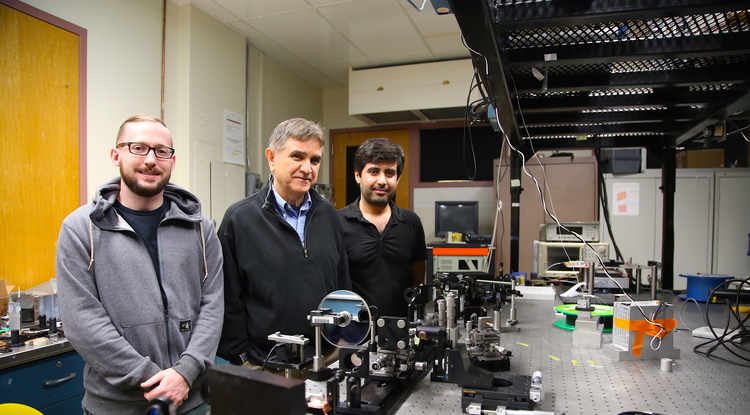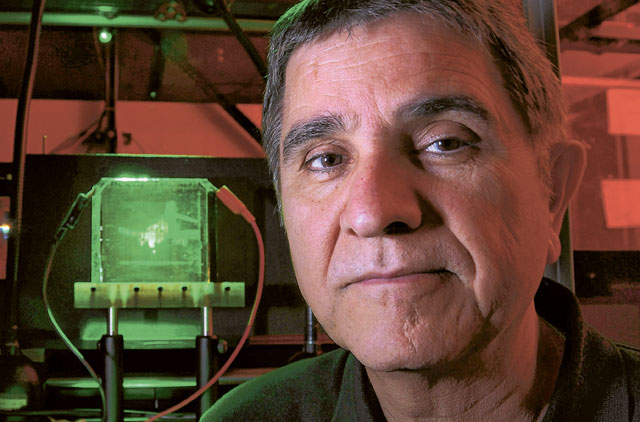NP Photonics proprietary fiber technology is used in various applications, including acoustic sensing, LIDAR, injection seeding and environmental sensing, coherent communication, optical trapping, and short pulse and SBS-free amplification applications.
Founded in 1998, NP Photonics is a leading manufacturer of specialty fiber lasers, fiber amplifiers and transport fibers for the near- and mid-infrared (IR) wavelength bands. The company makes 1-micron, 1.5-micron and 2-micron fiber lasers, multi-channel fiber laser systems, fiber amplifiers, and mid-infrared transport fibers. The company’s core strengths are technology innovation, product development, quality engineering and manufacturing world-class products for applications in Oil and Gas sensing, defense, metrology and research markets through distributors or sales representatives worldwide.
NP Photonics sponsored Mat Bevel Company’s coursework The Universe Within to help STEM education, outreach to minority populations and enhance diversity.

From left: Joshua Olson, a graduate student studying ultrafast fiber lasers; Nasser Peyghambarian; Veyesi Demir, a postdoctoral researcher working on optical computing. (Photo: Paul Tumarkin/Tech Launch Arizona)
Dr. Nasser Peyghambarian is the Founder and General Manager of NP Photonics. He joined the University of Arizona in 1982 where he is currently a Professor at both the College of Optical Sciences and the Department of Materials Science & Engineering. Dr. Peyghambarian is also Chair of Photonics and Lasers at the University of Arizona. He is the Director of the National Scienmce Foundation Center for Integrated Access Networks, 2008-present.
Dr. Peyghambarian’s research has been, and continues to be, widely published. His research interests include optical networks and optical communication, fiber optics, fiber lasers and amplifiers, quantum science and engineering, organic photonics, 3D holographic display and 3D telepresence, nonlinear photonics, optical modulators and switches, laser spectroscopy, nanostructures, and quantum dots. He has been an author on more than 600 scientific papers in peer-reviewed journals, and his research has been reported in over 700 invited talks, published conference proceedings, and contributed presentations. Additionally, he has authored or co-authored 28 books and book chapters and is the inventor on 36 patents.
He is the recipient of the University of Arizona 2007 Technology Innovation Award, International Francqui Chair, Belgium 1998-1999, TRW Young Faculty Award, and 3M Company’s Young Faculty Award. He is a Fellow of the American Association for the Advancement of Science, the Optical Society of America (OSA), the Society for optical engineers (SPIE), and the American Physical Society (APS).
In 2016, Dr. Peyghambarian was elected as a 2016 Fellow of the National Academy of Inventors, a high professional distinction accorded to academic inventors who have demonstrated a prolific spirit of innovation in creating or facilitating outstanding inventions that have made a tangible impact on quality of life, economic development, and the welfare of society. The technology that the UA licensed to NP Photonics represents one of the largest licensing agreements in UA history.

As a teacher, Dr. Peyghambarian has advised over 80 graduate students who can be found in leading positions around the world in industry, academia and government labs.
Both undergraduate and graduate students have benefited greatly from the research opportunities provided through Dr. Peyghambarian’s research group, and his combination of teaching, advising and research has prepared many students for successful careers in optics.
NP Photonics currently has over 1,400 lasers installed worldwide, and continues to grow through technology development, strategic partnerships and engagement with markets in which the company has a clear sustainable advantage. Since its inception, NP Photonics has successfully engaged in government-sponsored and customer-funded development programs to leverage core competencies and develop new technologies.
For more information visit NP Phontonics online.
